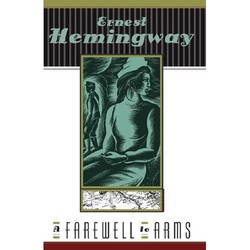
Author: Ernest Hemingway
# pages: 332
Date published: 1929 (Republished in 1957)
5-star rating: 4 out of 5 stars
Would you recommend it: Yes
To readers who enjoy happy endings, optimism, and inner peace, please take note that Ernest Hemingway’s A Farewell to Arms provides none of the above. After finishing the novel, readers realize that Pat’s reaction to the work in the film Silver Linings Playbook is completely justified, and they too may feel an aggressive desire to chuck the whole narrative out the window and resurrect Hemingway to answer one question: Why? In short, Hemingway’s post-war novel makes Life is good, Inc. seem like an ironic joke.
Nevertheless, to say that A Farewell to Arms provides only frustration and disillusionment would be a gross misrepresentation of a truly harrowing and emotionally complex novel. The retrospective narrative details Lieutenant Frederic Henry’s relationship with war nurse Catherine Barkley and conveys how the war simultaneously brings them together and tears them apart. While Hemingway’s minimalist writing style usually connotes stoicism, A Farewell to Arms represents such an effective union of content and form that his bare prose intensifies his characters’ resistance to World War I’s overwhelming internal and external environment. While Frederic is often a hesitant narrator, not allowing his post-war trauma to flood the narration, his rare but poignant moments of unrestrained emotion illuminate the pervasive effects of war and loss. The novel grapples with the physical and psychological wounds that result from extreme bloodshed and violence, but it also explores what it means to “survive” a war.
Although the retrospective narration makes it apparent that Frederic lives to tell his story, the novel is so tense and tragic throughout that it is easy to question if Frederic will in fact come out alive. Hemingway plays with suspense and memory in a way that emotionally invests the reader in a novel where the narration is otherwise guarded.
A Farewell to Arms puts the reader in the context of World War I, but it also takes the reader outside to a world where war is almost entirely inescapable. Frederic and Catherine take brief respites in hotels and other intimate spaces, but it remains painfully clear that even their relationship is not a complete remedy for the physical and psychological scars they incur.
A truly Modernist text, A Farewell to Arms illustrates the anxiety, irreparable destruction, and disconnect of war through the lens of Frederic and Catherine’s romance. The heartbreaking end will leave readers questioning humanity itself, but this tragedy is simultaneously the most frustrating and brilliant part of the novel. The injustice and jarring indifference that Frederic faces allow the reader to wrestle with the questions that torment Catherine and Frederic and no doubt plagued Hemingway and his contemporaries, questions we continue to grapple with today.
Review by Lauren Bly, A&S '15

 RSS Feed
RSS Feed
